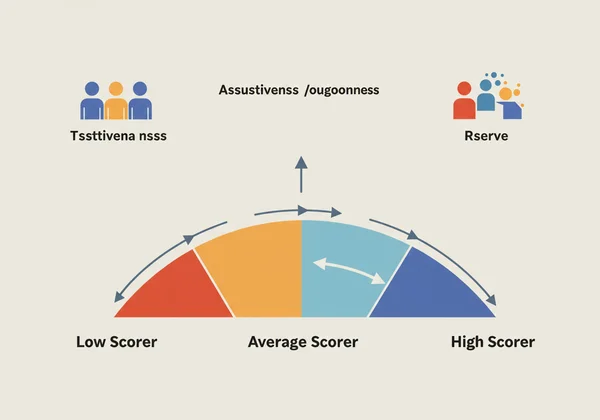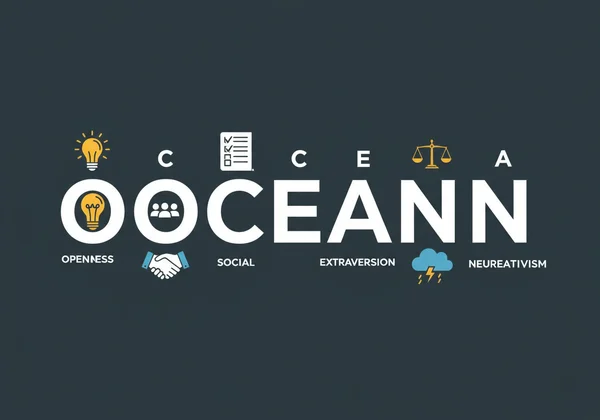Big 5 Results Explained: Understand Your Personality
So, you've just completed a Big 5 personality test. You have a report in front of you with five scores, maybe some graphs, and a set of labels: Openness, Conscientiousness, Extraversion, Agreeableness, and Neuroticism. It's fascinating, but what does it all mean? If you're asking, "What is the Big 5 personality test and what do these scores actually say about me?", you've come to the right place. This guide is designed to help you with interpreting your Big 5 results explained in a clear and meaningful way.
Your personality report is more than just a set of numbers; it's a map to understanding your core tendencies, preferences, and motivations. It’s a powerful tool for self-discovery. By learning to read this map, you can turn abstract data into actionable insights for personal and professional growth. If you haven't taken the test yet, you can start your free test on our platform to get your personalized report.
How to Interpret Your Big 5 Personality Scores
The first step in understanding your results is to grasp how the scoring works. A common point of confusion is thinking of these scores as grades in a school exam, where 100% is good and anything less is not. Personality testing is different. There are no "right" or "wrong" answers, and a high or low score is neither inherently good nor bad. Each end of the spectrum for a trait simply represents a different way of being, with its own unique strengths and challenges.
What Do Percentile Scores Really Mean?
Most Big 5 reports, including the one you get from our ocean personality test, present your scores as percentiles. A percentile score shows you how you compare to a large, standardized group of other people who have taken the same test. For example, if your score for Extraversion is at the 70th percentile, it means you scored higher in Extraversion than 70% of people in the comparison group.
This comparative context is key. It's not about how "extraverted" you are in an absolute sense, but how your level of extraversion relates to others. This helps you understand your unique place on the personality spectrum. It's a snapshot of your tendencies, not a permanent label.

Beyond the Numbers: High vs. Low Scores Explained
Understanding the distinction between high and low scores is crucial. Let's break it down:
- High Scorers (typically >60th percentile): You express the traits of that dimension more strongly and frequently than the average person.
- Average Scorers (typically 40th-60th percentile): You are balanced in that trait, exhibiting behaviors from both ends of the spectrum depending on the situation.
- Low Scorers (typically <40th percentile): You express the traits of that dimension less strongly and frequently. This simply means you lean toward the opposite end of the spectrum.
For instance, a low score in Extraversion doesn't mean you are "bad" at socializing; it indicates a preference for solitude and quieter environments, which is often described as introversion. Every score provides valuable information for your journey to discover your personality.

Decoding Each OCEAN Trait in Your Report
The Big 5 model is often remembered by the acronym OCEAN (or CANOE). Each letter represents one of the five broad domains of human personality. Understanding these is the core of interpreting your results.

Openness: Your Imagination & Curiosity Levels
This trait, often called Openness to Experience, describes your intellectual curiosity, creativity, and preference for novelty and variety.
- High Scorers are imaginative, curious, and open-minded. They enjoy abstract ideas, new experiences, and tackling creative challenges. They are often seen as inventive and intellectually adventurous.
- Low Scorers are more practical, conventional, and prefer routine. They find comfort in the familiar and tend to be more straightforward and data-driven in their approach.
Conscientiousness: Order, Discipline & Goal Orientation
Conscientiousness relates to your level of self-discipline, organization, and goal-directed behavior. It reflects how you manage your impulses and responsibilities.
- High Scorers are organized, dependable, and persistent. They are planners who take their obligations seriously and work diligently toward their goals. They are often perceived as reliable and hard-working.
- Low Scorers are more spontaneous, flexible, and easy-going. They may be less organized but are great at adapting to changing circumstances and can be more comfortable with improvisation.
Extraversion: Your Social & Energy Preferences
This dimension describes where you draw your energy from and your tendency to seek stimulation from the outside world, particularly in social settings.
- High Scorers are extraverts. They are outgoing, energetic, and talkative. They feel energized and thrive in social situations and often enjoy being the center of attention.
- Low Scorers are introverts. They are more reserved, thoughtful, and deliberate. They draw energy from spending time alone and may find large social gatherings draining.
Agreeableness: Compassion, Cooperation & Empathy
Agreeableness refers to your interpersonal tendencies. It reflects how you typically interact with others, particularly concerning cooperation and social harmony.
- High Scorers are compassionate, trusting, and helpful. They are motivated to maintain positive relationships and are generally cooperative and considerate of others' feelings.
- Low Scorers are more competitive, skeptical, and analytical. They are not afraid to challenge others or prioritize their own objectives, which can make them excellent negotiators and critical thinkers.
Neuroticism: Emotional Stability & Stress Response
Neuroticism measures your emotional stability and your tendency to experience negative emotions like anxiety, anger, and sadness.
- High Scorers are more emotionally reactive and sensitive to stress. They may experience mood swings and worry more frequently, but this sensitivity can also make them more empathetic and aware of potential threats.
- Low Scorers are emotionally stable, calm, and resilient. They are less easily upset and can handle stress well, remaining composed even in difficult situations.
Connecting the Dots: Understanding Trait Combinations
Your personality is not just a list of five independent traits. The real insight comes from seeing how they connect and interact. No single trait defines you; it's the unique combination that creates the rich tapestry of who you are. The free big 5 test provides the foundational data for this deeper exploration.
How Two or More Traits Interact to Shape You
Consider how different traits might work together. A person high in both Conscientiousness and Openness might be a disciplined innovator—someone who not only comes up with creative ideas but also has the focus to bring them to life. In contrast, someone high in Openness but low in Conscientiousness might be a brilliant visionary with a dozen unfinished projects.
Similarly, a person high in Extraversion and Agreeableness is likely to be a warm, popular, and enthusiastic team player. An individual high in Extraversion but low in Agreeableness might be more assertive and dominant—a natural leader who is comfortable taking charge, even if it ruffles some feathers. Looking at these combinations provides a much more nuanced and accurate picture of your personality.

Turning Insights into Action: Your Personalized Growth Plan
The ultimate goal of understanding your Big 5 results is to use them for personal growth. Once you recognize your natural tendencies, you can develop strategies to leverage your strengths and manage your challenges. For example, if you're low in Conscientiousness and struggle with deadlines, you can implement systems like calendars and reminders to stay on track. If you're high in Neuroticism, you can proactively practice mindfulness and stress-management techniques.
This is where true value lies. For those seeking an even deeper dive, our platform offers an optional AI-driven enhanced report. This report goes beyond the basic scores to provide a highly personalized analysis of your unique trait combinations, offering concrete, actionable advice for your career, relationships, and well-being. You can unlock deeper insights to create a tailored growth plan.

Your Big 5 Journey: From Scores to Self-Awareness
Interpreting your Big 5 results is the beginning of an exciting journey toward greater self-awareness. Your scores are not meant to put you in a box but to provide you with a scientifically validated framework for understanding yourself better. They highlight your natural inclinations, helping you navigate your world more effectively.
Remember, every personality profile has its own set of advantages. The key is to understand your unique makeup and use that knowledge to make conscious choices that align with your goals and values. We encourage you to use this guide as a starting point. Ready to begin? Take our scientific personality test today and start your path to deeper self-knowledge.
We'd love to hear about your experience! Feel free to share any insights or questions in the comments below.
Common Questions About Your Big 5 Personality Results
What is the Big 5 personality test, and why is it important?
The Big 5 personality test is a comprehensive, evidence-based assessment tool used by psychologists to measure the five major dimensions of personality: Openness, Conscientiousness, Extraversion, Agreeableness, and Neuroticism. It is important because it is based on the Five-Factor Model, the most widely accepted scientific model of personality structure. Its results provide reliable and valid insights into your core traits, helping with everything from career planning to improving personal relationships.
How accurate are Big 5 test results, and are they scientifically valid?
The Big 5 model is considered the gold standard in personality psychology due to its strong scientific validity. Decades of research have shown that the five traits are consistent across different cultures and that test results are generally stable over time for adults. While no test is 100% perfect, a well-designed five factor model test like the one offered on our site provides a highly accurate reflection of your fundamental personality traits.
How can I use my Big 5 results for personal or career growth?
You can use your results to identify careers that align with your natural strengths. For example, someone high in Conscientiousness might excel in detail-oriented roles, while someone high in Extraversion may thrive in sales or public relations. For personal growth, understanding your traits can help you improve communication in relationships, manage stress more effectively, and set realistic self-improvement goals. To start applying these insights, get your free report and analyze your profile.
What is the difference between Big 5 and other personality tests like MBTI?
The main difference lies in their scientific foundation. The Big 5 is an empirically derived model based on statistical analysis of language and personality surveys, making it the preferred tool in academic and research settings. The Myers-Briggs Type Indicator (MBTI) categorizes people into one of 16 distinct "types." While popular, the MBTI has less empirical support for its rigid type-based categories and its test-retest reliability is lower than the Big 5. The Big 5 model measures traits on a spectrum, which most psychologists agree is a more accurate representation of personality. You can start your test now to experience a scientifically backed assessment.